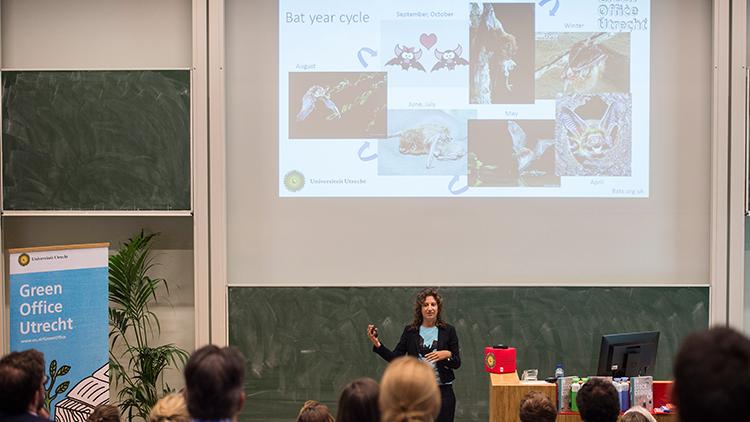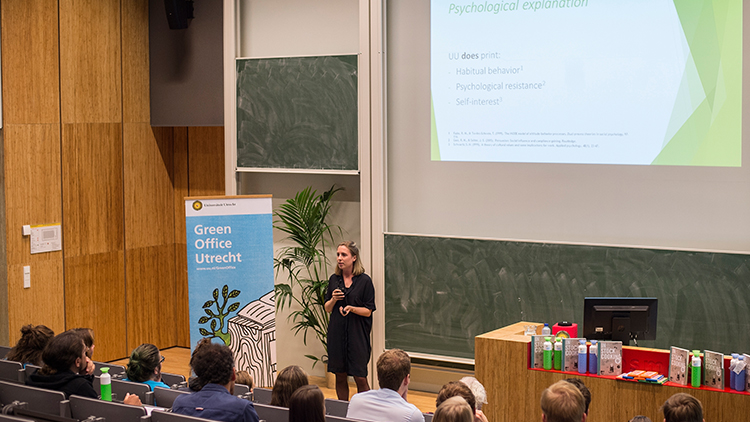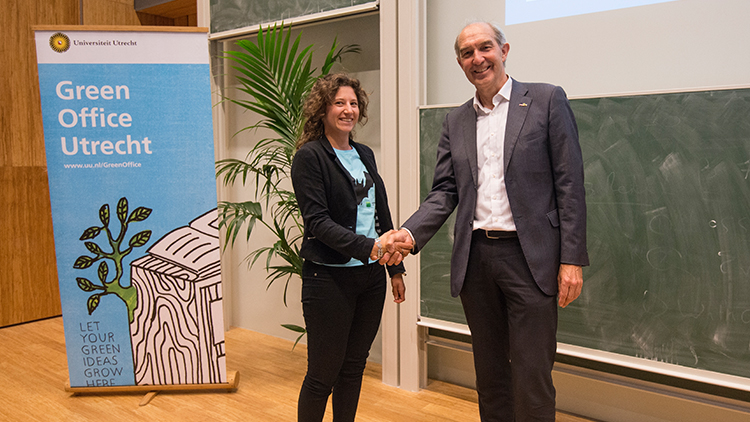Living Lab research leads to workshop on ‘how to order lunch’

For the fourth consecutive year, the Green Office organized the Living Lab Symposium. During this yearly convention, several students present the results of the research they’ve done to make Utrecht University more sustainable. A jury chooses the best research, and this year saw the first public vote prize.
One of the research presentations discussed on June 8th has already led to concrete action: the study by six master’s students on how to fight food waste, as commissioned by the University Facilities Centre (FSC).
The students logged the amount of leftover food of all Sodexo lunches during two weeks. “Calculated in liters of water and CO2 footprint, the leftover food and drink could fill 85.538 bathtubs with water, and you could drive 3841 kilometers in a car,” two of the six researchers say.
There are obvious ethical and financial objections to wasting food, plus it’s bad for the environment. At the UU alone, 1.5 million euros are spent on Sodexo lunches. The students suggest only ordering sandwiches for the guests who have RSVP’d to the lunch. They also suggest organizing workshops for those who order lunches regularly, so they’ll be able to estimate better how much food and drink is required. This idea has since been realized: on June 21st, the Green Office Utrecht is organizing a workshop – mostly aimed at secretaries, “because they’re usually the ones ordering lunches”. Some of them are already great at ordering measured portions. “One of them knows exactly which of her colleagues eat a lot, and who eats very little, and she bases her food orders on their preferences.”
Merijn Smelt, department manager at the University Facilities Centre and the one who commissioned the research project, states he’s very happy with the Living Lab. “The students do a research project in a six week time span that would take university employees much longer, because they’d have to do it along with all their usual tasks.”
Smelt had more examples of doable propositions presented by students. An earlier group researched the sustainability of compostable disposable cups, which will have a trial at the Androclus building after the summer. Last year, another group of students researched ways to make the UU lunches more sustainable, proposing to cooperate with local, biological farmers. Recently, the canteen offered strawberries grown by one of these local farmers, and more and more local products will be offered. In the menu of ‘lunches to order’, a vegan variant was added.
Anti-print posters and bats

Despite the quick realization of the food waste research, the students didn’t win the prize – the audience voted for the group who researched the printing behavior of UU employees and students. Psychology student Lotte van Neer found that at the UU, a whopping 35 million pages are printed every year. That’s equal to 1036 liters of drinking water, 496 kilometers in a car, 95 years of energy use, and 3171 trees. To make students aware of their printing behavior, she hung posters (made from recycled trees) near the printers, informing those using the printers that printing 17 pages less a year would save 324 liters of water, 1700 watts of energy and 1.75 liters of CO2 emission. She hopes to convince students to print less by offering this insight in how printing affects the environment.
The jury prize was awarded to Zora Tamas. The master’s student in Environmental Biology wants to find out whether all the construction work – and consequently, the changing landscapes – at the Uithof influences the bat population. Four of the 21 species of bats found in the Netherlands, live at the Uithof, as was shown by an earlier inventory. The jury chose her research because the relationship with your study/work environment is important. The research shows a broader perspective on sustainability and our impact on the eco systems we inhabit, the jury members explained.
Because the bats have only just come out of hibernation, Zora has not been able to finish her research yet, so it’s not clear yet whether or not the bat population has suffered. She was able to explore with her bat detector. So far, she’s been able to identify two kinds of bats.
Zora explains why De Uithof needs to take care of this protected species. They have an important role, both ecologically and economically. For instance, they eat about 3000 flies or mosquitoes a night, they’re food for owls, help move around seeds, and you can deduce the ecological health of any area by looking at the bat populations. Furthermore, the mammals – who have litters once or twice a year – can act as research populations for biology students, and can attract bat watchers to De Uithof.
If her research shows the bat population has shrunk, she’ll campaign for changes in the environment to regrow the bat population. “Hibernation spots, shrubbery and vegetation, more trees, green roofs, and protection from cats that like to eat a bat or two.”
 Vice president of the Executive Board Anton Pijpers – veterinarian by trade – is elated to be able to give Zora the jury award. Pijpers: “As a veterinarian you tend to look at the diseases bats can transfer, like ebola. Zora shows the positive sides of having a bat population.”
Vice president of the Executive Board Anton Pijpers – veterinarian by trade – is elated to be able to give Zora the jury award. Pijpers: “As a veterinarian you tend to look at the diseases bats can transfer, like ebola. Zora shows the positive sides of having a bat population.”